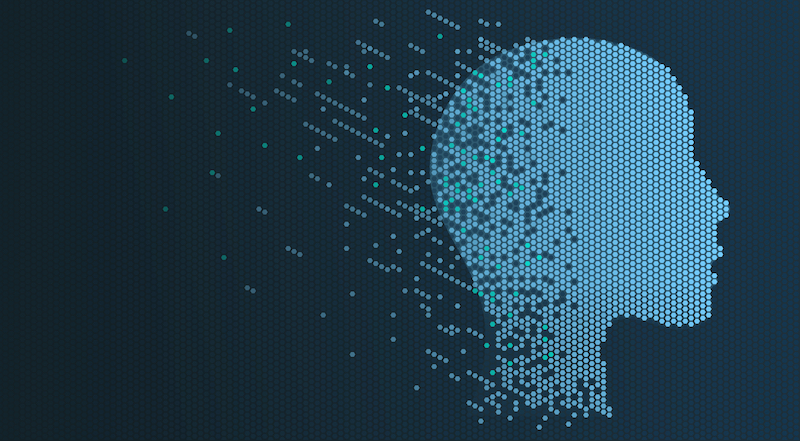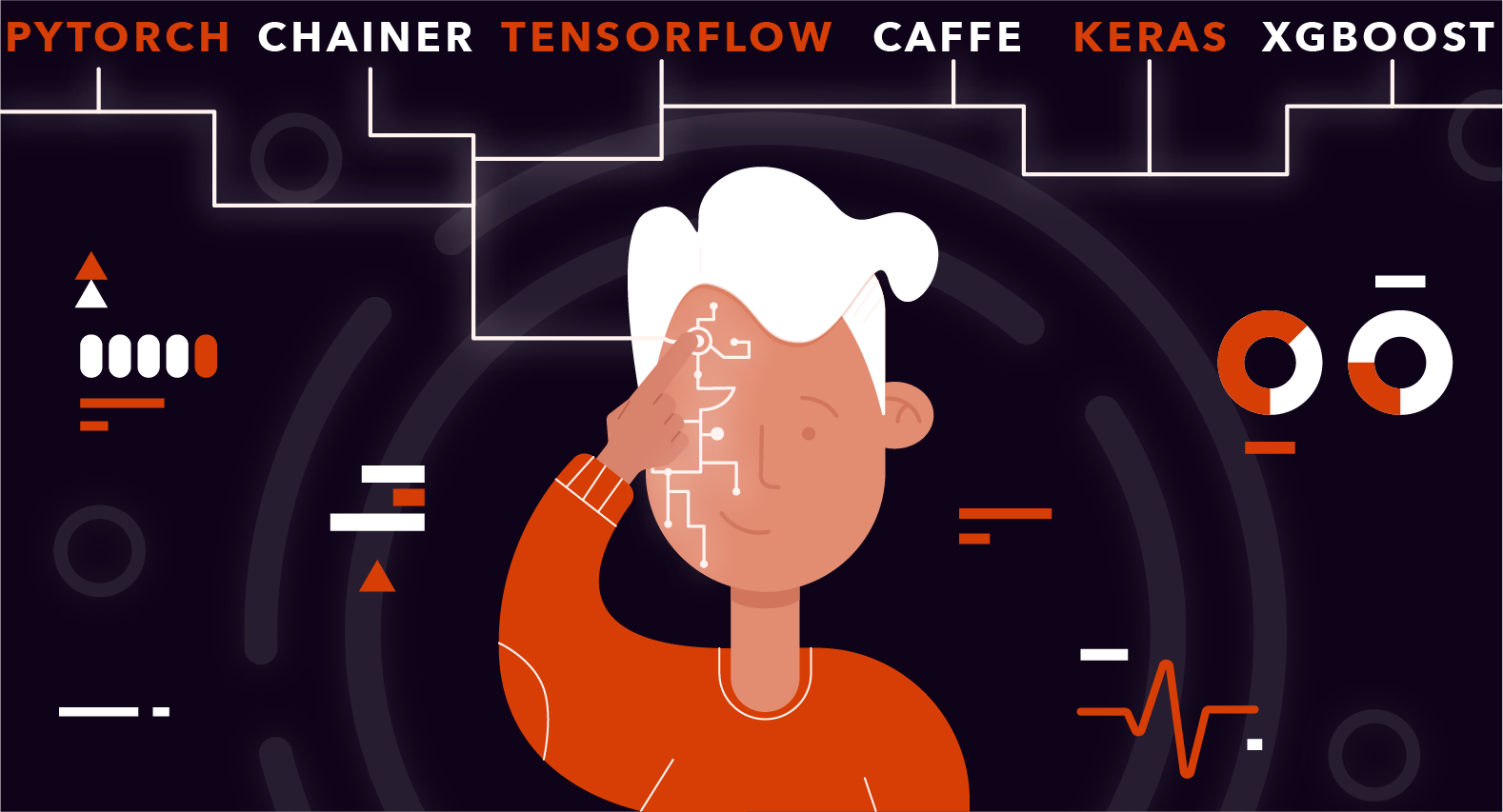
Choosing a Framework for your AI Project

Artificial intelligence is one of the most significant technologies of recent times. From solutions that recognize symptoms of a heart attack to face aging apps and voice assistants. AI has penetrated every field: medicine, social media, entertainment. A lot of companies, large and small, turn to AI in the hope of expanding the possibilities of their business. The decision to implement AI solutions comes with the need for a relevant framework. In this article, we are going to review 7 popular frameworks for AI.
TensorFlow
TensorFlow is used for voice and image recognition as well as for language processing like Google Translate. Works best for complex projects, including multi-layer neural networks. DeepMind, Uber, Airbnb and Dropbox use this platform.
Tensorflow has API in Python on top of C and C++. The framework has a flexible ecosystem of tools and libraries as well as a vibrant community. Tensorflow enables data scientists to use the most recent Machine learning tools. Developers can create and deploy machine learning applications
Read also:How Big Data and AI work Together
TensorFlow comes with intuitive API interfaces (for example, Keras) that enable fast model iteration and simple debugging. As a multiplatform solution, it allows to teach and deploy models in cloud and on-premise regardless of the used language.
There is also TensorFlow Lite, an open-source solution that is used for deployment of machine learning on smartphones or IoT devices. Next, Tensorflow.js is a solution that allows to create and teach a model in JavaScript and deploy it in the browser.
Pros:
- A large number of manuals and documentation;
- Powerful tools for monitoring the learning process of models and visualization (Tensorboard);
- A large community of developers and tech companies;
- It provides service models;
- It supports distributed learning;
Cons:
- A steep learning curve;
- Low user-friendliness;
- Not the fastest one in benchmarking;
- The need to control video RAM;
- Documentation;
PyTorch
PyTorch was developed by Facebook and used by Twitter and Salesforce among others. It’s a good solution for when you need to teach models fast and efficiently.
PyTorch is an environment for machine learning written in Python. It enables Tensor calculations with GPU acceleration.
With PyTorch, data engineers can change the network behaviour on the go. The framework offers dynamic calculations graphs that allow you to process input and output of a variable length, which is useful if you are dealing with recurrent neural networks. Developers can use C and C ++ with the help of API extension for Python.
Unlike TensorFlow, PyTorch is less flexible in terms of supporting multiple platforms. It lacks built-in data visualization tools but has tensorboardX as an external alternative.
When deploying networks on the GPU, PyTorch will take up only the necessary video memory.
Pros:
- A modular structure, so you can combine ready-made modules;
- a model creation process is quite simple and transparent;
- The framework supports popular debugging tools such as pdb, ipdb, or PyCharm debugger;
- Simple to create custom layers and work on GPU;
- Has a wide range of pre-trained models;
Cons:
- Documentation;
- Lack of model support
- Lack of monitoring and visualization interfaces
Keras
Keras is a minimalistic deep learning library in Python that runs on top of TensorFlow, Theano, or CNTK. It is compact, modular and expandable solution that is aimed at accelerating work with neural networks. Keras is chosen for smaller projects due to mediocre performance as compared to Tensorflow.
Keras supports a wide range of neural network layers: convolutional, recurrent, and dense.
The library contains numerous implementations of widely used building blocks of neural networks: layers, target, and transfer functions, optimizers, as well as a variety of tools that simplify work with images and text.
Keras is one of the best deep learning frameworks for translation, image and speech recognition.
Pros:
- Fast and simple prototyping;
- Documentation;
- It’s lightweight while enabling deep learning networks and multiple layers;
- Has configurable modules
- Intuitive interface;
- Build-in support for teaching in more than one GPU;
- Built inside TensorFlow
- It can be configured as an evaluator for TensorFlow and trained on GPU clusters on the Google Cloud platform;
Cons:
- Unsuitable for large projects;
- Not easy to customize;
- Not always suitable for a highly specific deep learning model;
Caffe
A deep learning framework in C++ with Python interface. Caffe is characterized by expressiveness, speed and modular structure. Caffe is a good solution for training models, processing images and improving neural networks. It also supports CNN and feedforward neural networks. A few years ago, Facebook released Caffe 2, which is suitable for both mobile and large-scale development in the production environment.
Pros:
- Pre-trained models for creating demo apps;
- Fast, scalable and occupies little memory space;
- It works well with other frameworks such as PyTorch;
- Optimized work with the server;
Cons:
- Little to none community support;
- Not the best solution for complex networks;
- Lacks in debugging tools and tech support;
Deeplearning4j
Deeplearning4j ( DL4J) is a good choice for Java programmers. It is a commercial-grade, open-source, distributed library written for Java and Scala. DL4J provides good support for various types of neural networks, from convolutional to recurrent and recursive. This framework is used for image recognition, natural language processing, vulnerability search and text analysis.
Pros:
- Reliable, flexible and efficient;
- It can process large amounts of data without compromising speed;
- Compatibility with Apache Hadoop and Spark, on distributed CPU or GPU;
- Documentation;
- Community;
- Enterprise option;
Cons:
- The use of Java for machine learning is usually a costly and time-consuming way;
XGBoost
XGBoost is an open-source framework that offers a gradient boosting system for C ++, Java, Python, R, Julia. It boasts high performance, flexibility and portability. XGBoost belongs to the realm of classical machine learning frameworks.
Originally, it was a research project of Tianji Chen and Carlos Gestrin as part of the Distributed [Deep] Machine Learning Community, but later it was expanded and presented to the public at the SIGKDD conference in 2016.
XGBoost focuses on computational speed and model performance and is a suitable solution for solving regression, classification, and sequencing tasks. If the data can be presented in the form of a table, then the accuracy and performance will be significantly higher than that of DeepLearning solutions.
The framework is compatible with Windows, Linux and OS X. It also supports AWS, Azure and Yarn clusters, works well with Flink, Spark.
Pros:
- A fast and convenient way to train models such as “decision tree”;
- Accuracy;
- Portability;
- Ideal for hypothesis testing;
Cons:
- Field-specific;
Chainer
One more Python deep learning framework supported by Intel, IBM, NVIDIA, and AWS. It’s a flexible, intuitive solution that runs on multiple GPUs with little effort, supports CUDA and various networks such as feed-forward convnets, recurrent and recursive. This framework is mainly used for voice recognition, machine translation, and key analysis.
Pros:
- It beats any other Python framework in terms of speed;
- It makes code intuitive and easy to debug;
- supports various network architectures;
- The ability to modify existing networks in the runtime;
Cons:
- Less popular than other Python networks;
- A small community, so not much help;
AI and machine learning development with NCube
We at NCube build teams around AI stack consisting of Ukraine’s best machine learning, data science, and data engineering talent. The expertise of our engineers spans cognitive computing, computer vision, machine learning, and deep learning. We can build your data science team in the same way we did for Fetch AI.
Recommended articles



